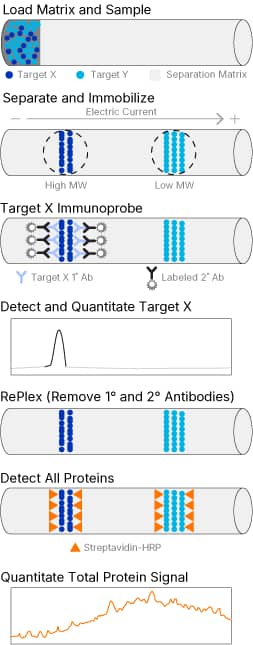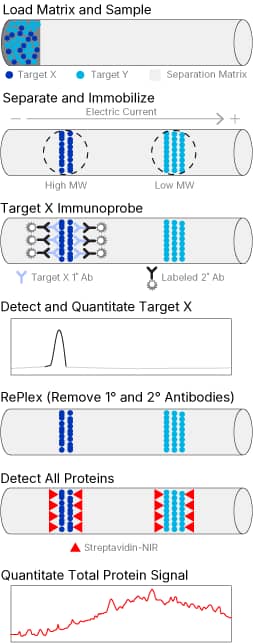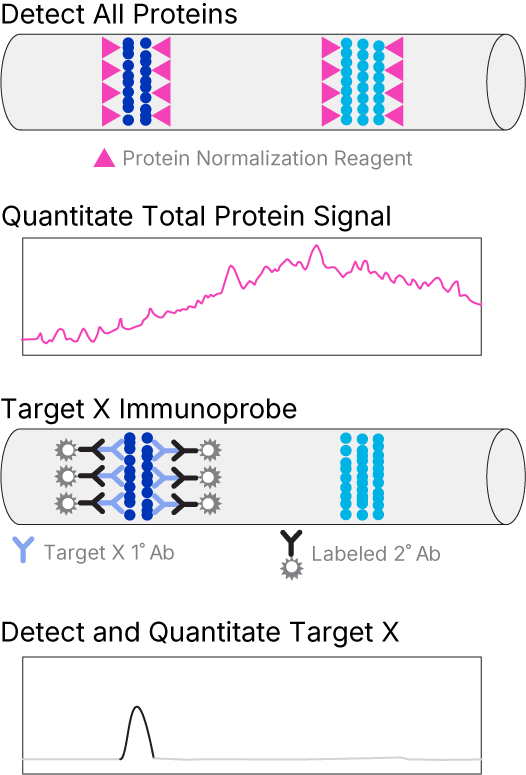Automated Total Protein Normalization with Simple Western
When measuring protein expression, total protein normalization (TPN) may be more reliable than housekeeping proteins, as the expression of housekeeping proteins can vary with experimental conditions. However, TPN often requires additional time-consuming and messy gel staining steps. With Simple Western™ technology, reproducible TPN is integrated seamlessly with your immunoassay. The result? You can quickly see if your samples contain a consistent protein load, identify experimental setup and user errors, and effectively normalize expression of your target protein to get accurate and consistent data, giving you in your results.
Three Methods to Choose from for Total Protein Normalization with Simple Western
TPN using RePlex and Chemiluminescent-based Detection
TPN using RePlex and Chemi detection allows total protein detection following RePlex to remove antibodies from a chemiluminescent or fluorescent immunoassay.
TPN using RePlex and NIR-based Detection
TPN using RePlex and NIR detection allows total protein detection following RePlex to remove antibodies from a chemiluminescent or fluorescent immunoassay.
TPN using the PN Channel
TPN using the Protein Normalization (PN) channel allows the detection of target proteins by an immunoassay with chemiluminescence or NIR or IR fluorescence detection and total protein detection in the same capillary using an independent fluorescence channel.
Which TPN Assay is Right for You?*
| TPN using RePlex and Chemi detection1 | TPN using RePlex and NIR detection | TPN using PN channel | |
| Instrument | Jess, Abby, Leo | Jess | Jess |
| Sample conc. | Various | 0.5–2.5 mg/mL | 0.4–1.2 mg/mL |
| MW range | 2–440 kDa | 12–440 kDa2 | 2–230 kDa |
| RePlex? | Yes | Yes | No |
| Immunoassay | Chemi, NIR, IR (RePlex Probe 1) | Chemi, NIR, IR (RePlex Probe 1) | Chemi, IR, NIR |
| Total protein | Chemi (RePlex Probe 2) | NIR (RePlex Probe 2) | PN channel |
TPN using RePlex and Chemi Detection
This method is recommended to start your TPN assay development because it's proven to work with various MW ranges and sample concentrations.
TPN using RePlex and Chemi detection allows total protein detection following RePlex to remove antibodies from an immunoassay with chemiluminescent or fluorescent probes. The Chemiluminescent Total Protein Assay can be used to detect all the proteins in your lysate, similar to a Coomassie or SYRPO Ruby stained gel. Chemiluminescent Total Protein Assay attaches biotin to all the proteins in your sample instead of an antibody for a specific target. Then, incubation with Streptavidin-HRP followed by Luminol/Peroxide generates a chemiluminescent signal for the total captured protein.
| Compatible instruments | Jess, Abby, Leo |
| Sample concentration | Various |
| MW range | 2–440 kDa |
| Compatible with RePlex? | Yes |
| Multiplex immunoassay channels | Chemi, NIR, IR (RePlex Probe 1) |
| Total protein detection channel | Chemi (RePlex Probe 2) |
| Additional materials required |
|
|


TPN using RePlex and NIR Detection
Recommended for low abundance targets in high-concentration samples.
Like TPN using RePlex and Chemi detection, TPN using RePlex and NIR detection attaches biotin to all the proteins in your sample. Incubation with Streptavidin-NIR generates an NIR signal for the total captured protein. TPN using RePlex and NIR detection is linear for high sample concentrations (0.5–2.5 mg/mL), facilitating the analysis of low abundance targets. The protocol described here has been tested on whole-cell lysates, brain tissue, and muscle-skeletal tissue homogenates. This protocol guides your TPN assays with high-concentration samples to measure low abundance targets, including tips for setting up your assay and analyzing the data.
| Compatible instruments | Jess |
| Sample concentration | 0.5–2.5 mg/mL |
| MW range | 12–440 kDa |
| Compatible with RePlex? | Yes |
| Multiplex immunoassay channels | Chemi, NIR, IR (RePlex Probe 1) |
| Total protein detection channel | NIR (RePlex Probe 2) |
| Additional materials required |
TPN using the PN Channel
Recommended for low and medium MW targets.
TPN using the PN channel allows the detection of target proteins by an immunoassay with chemiluminescent or fluorescent probes and total protein in the same capillary. Just load the PN reagent into the assay plate, and Jess will take care of the rest. The PN reagent binds to proteins immobilized in the same capillary as your immunoassay via primary and secondary amine interactions.
| Compatible instruments | Jess |
| Sample concentration | 0.2–1.2 mg/mL |
| MW range | 2–230 kDa range |
| Compatible with RePlex? | No |
| Multiplex immunoassay channels | Chemi, IR, NIR |
| Total protein detection channel | PN channel |
| Additional materials required | Protein Normalization Module |



